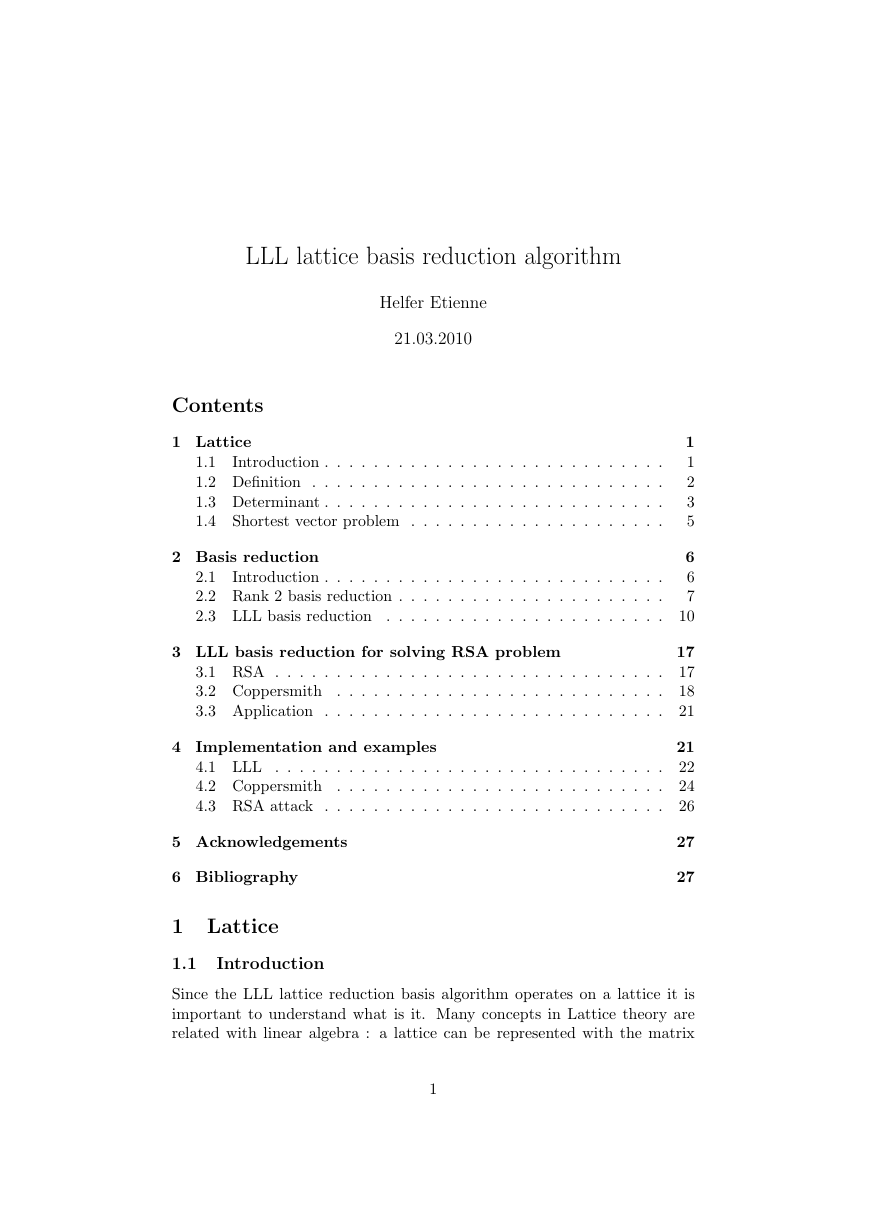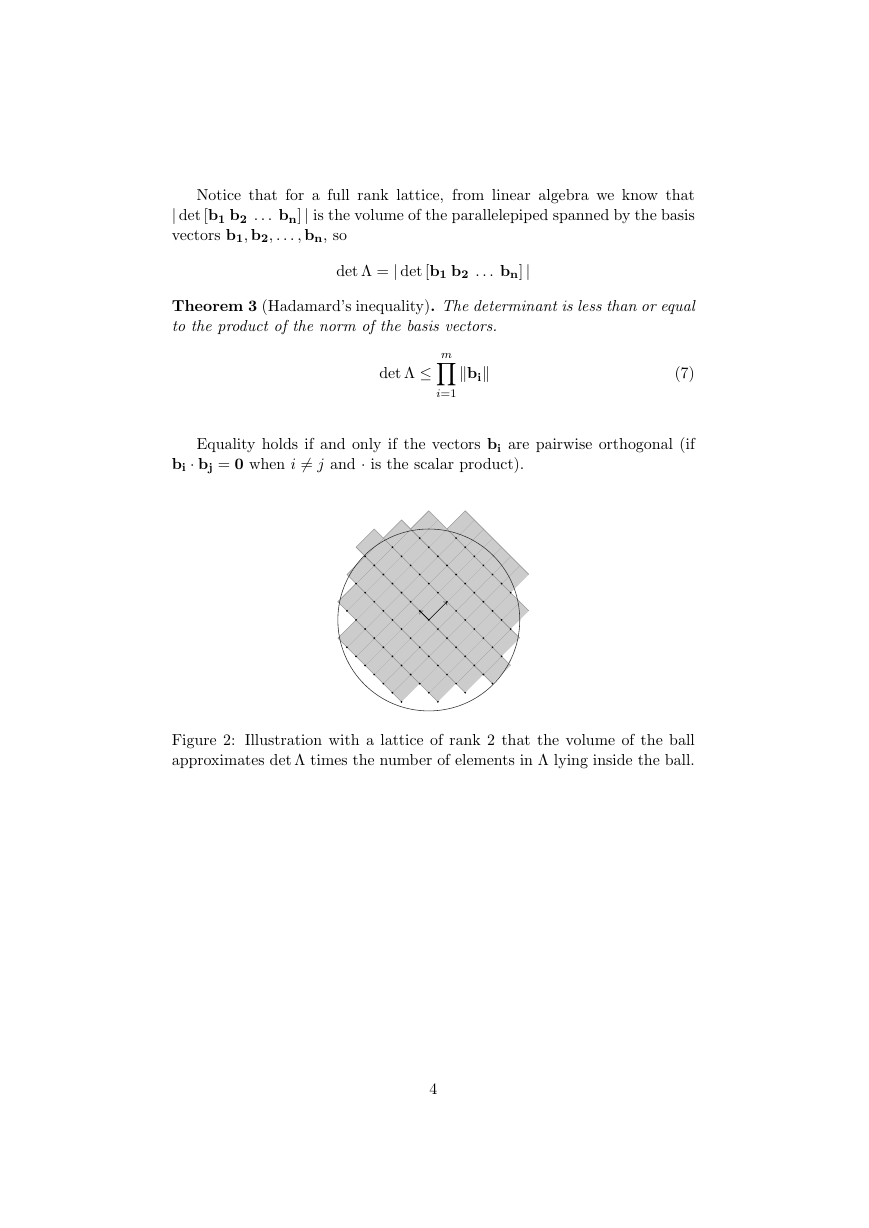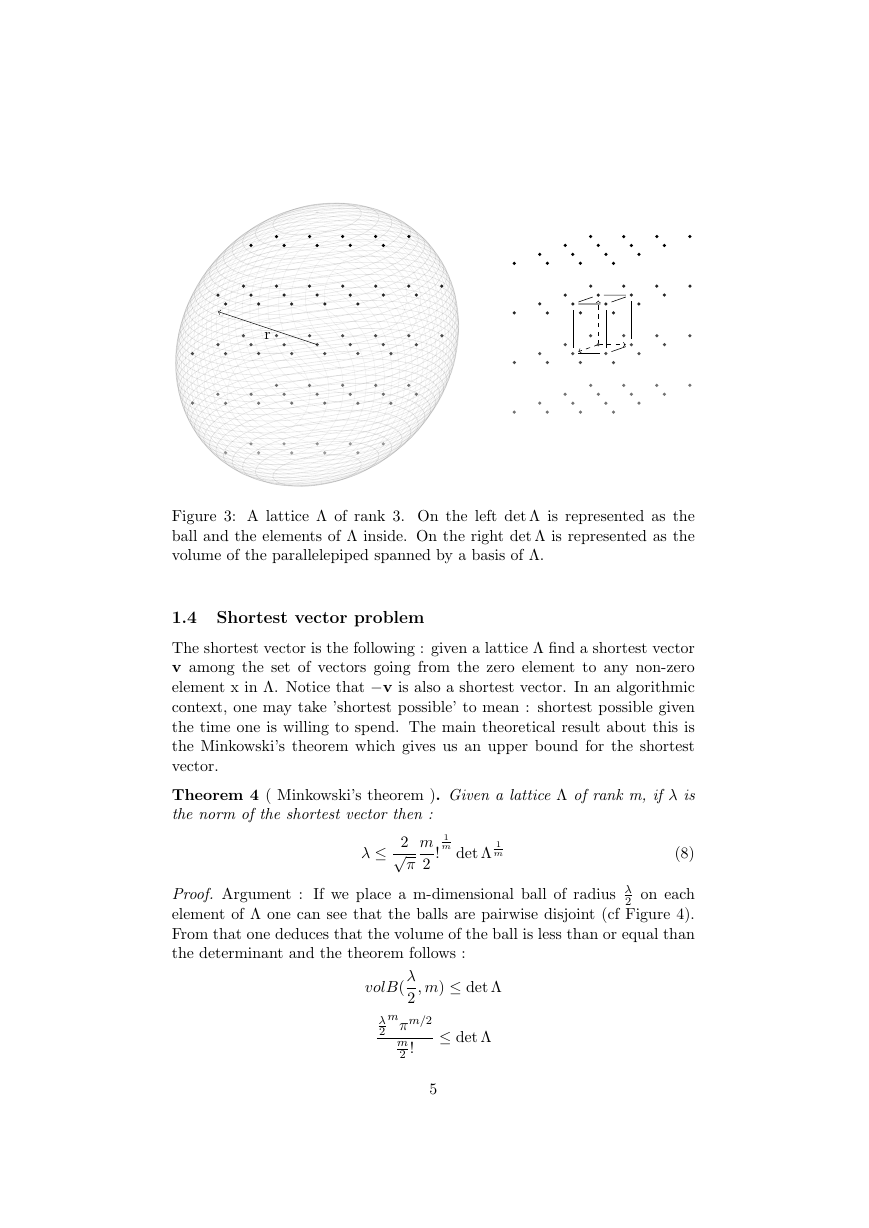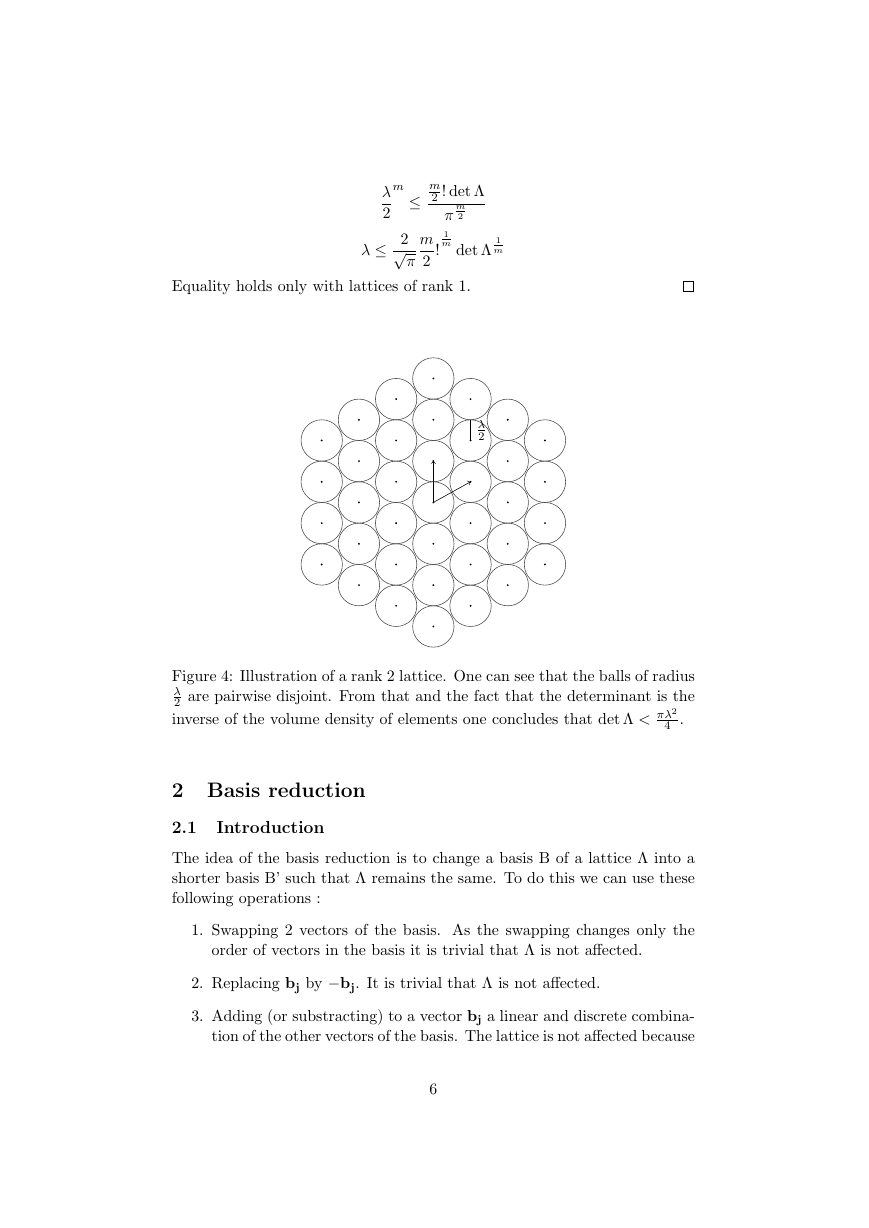LLL lattice basis reduction algorithm
Helfer Etienne
21.03.2010
Contents
1 Lattice
1.1
Introduction . . . . . . . . . . . . . . . . . . . . . . . . . . . .
1.2 Definition . . . . . . . . . . . . . . . . . . . . . . . . . . . . .
1.3 Determinant . . . . . . . . . . . . . . . . . . . . . . . . . . . .
1.4 Shortest vector problem . . . . . . . . . . . . . . . . . . . . .
2 Basis reduction
2.1
Introduction . . . . . . . . . . . . . . . . . . . . . . . . . . . .
2.2 Rank 2 basis reduction . . . . . . . . . . . . . . . . . . . . . .
2.3 LLL basis reduction . . . . . . . . . . . . . . . . . . . . . . .
3 LLL basis reduction for solving RSA problem
3.1 RSA . . . . . . . . . . . . . . . . . . . . . . . . . . . . . . . .
3.2 Coppersmith . . . . . . . . . . . . . . . . . . . . . . . . . . .
3.3 Application . . . . . . . . . . . . . . . . . . . . . . . . . . . .
4 Implementation and examples
4.1 LLL . . . . . . . . . . . . . . . . . . . . . . . . . . . . . . . .
4.2 Coppersmith . . . . . . . . . . . . . . . . . . . . . . . . . . .
4.3 RSA attack . . . . . . . . . . . . . . . . . . . . . . . . . . . .
5 Acknowledgements
6 Bibliography
1 Lattice
1.1
Introduction
1
1
2
3
5
6
6
7
10
17
17
18
21
21
22
24
26
27
27
Since the LLL lattice reduction basis algorithm operates on a lattice it is
important to understand what is it. Many concepts in Lattice theory are
related with linear algebra : a lattice can be represented with the matrix
1
�
of its basis, it has a determinant, and so on. Later we will need linear
algebra methods and matrix properties for the LLL algorithm. I won’t give
a complete and precise view of the lattice theory but favor the geometrical
point of view and focus on the elements that are needed to understand LLL
basis reduction.
1.2 Definition
A lattice is a discrete subgroup of an Euclidean vector space.
In general
the vector space is Rn or a subspace of Rn. It is conveniant to describe a
lattice using its basis. The basis of a lattice is a set of linearly independent
vectors in Rn which can generate the lattice by combining them. Notice
that different bases can generate the same lattice (cf. figure 1).
Definition 1. A set of vectors {b1, b2, . . . , bm} in Rn is linearly indepen-
dent if the equation
c1b1 + c2b2 + ··· + cmbm = 0 where ci ∈ R
(1)
accepts only the trivial solution c1 = c2 = ··· = cm = 0
Theorem 1. If a set of vectors in Rn contains more vectors than n (if
m > n), then this set of vectors is not linearly independent.
Definition 2. A subspace of Rn is a an arbitrary set H that has the following
properties :
1. the nul vector 0 is an element of H
2. H is close under addition : for every u and v in H, their sum u + v
is an element of H
3. H is close under scalar multiplication : for every u in H and scalar c,
the vector cu is an element of H
Notice that Rn is a subspace of Rn
Definition 3. A basis B of a subspace H of Rn is a set of linearly indepen-
dent vectors in Rn that generates H.
Definition 4. A lattice Λ is a discrete subgroup of H generated by all the
integer combinations of the vectors of some basis B :
Λ =
Zbi =
zibi where zi ∈ Z, bi ∈ Rn
i=1
i=1
2
B = {b1, b2, ..., bm} where bi ∈ Rn
H =
Rbi =
cibi where ci ∈ R, bi ∈ Rn
m
i=1
m
m
m
i=1
(2)
(3)
(4)
�
Definition 5. The rank m of a lattice Λ generated by a basis B of a subspace
H of Rn is the number of vectors in B.
Theorem 1 implies that m ≤ n. If m = n then H is Rn and Λ is a full
rank lattice.
b2
b1
b2
b1
b2
b1
b1
Figure 1: Examples of lattices generated with different bases in R2. The
first and the second lattice are the same. The first three lattices are rank 2
and the fourth is rank 1.
1.3 Determinant
The determinant of a lattice Λ (det Λ) is an important numerical invariant
of Λ. Geometrically speaking, det Λ is the volume of the parallelepiped
spanned by the basis. The determinant does not depend on the choice of
the basis.
Another more general perspective is to consider det Λ as the inverse of
the volume density of elements in Λ.
Definition 6. The volume of a n-dimensional ball B of radius r is given by
proposition
where n
2 ! is inductively defined by 0! = 1, 1
volB(r, n) = rnvolB(1, n) =
√
2 , and n
2 ! =
n
2 !
π
2 ! = n
2
rnπn/2
(5)
n−2
2 !
Definition 7 (Determinant definition). det Λ is the volume of the m-dimensional
ball B, where m is the rank of Λ, divided by the number of elements belonging
to Λ in B when radius of B tends to infinity.
det Λ = lim
r→∞
(6)
Theorem 2. Given a lattice Λ with a basis {b1, b2, . . . , bi} then the deter-
minant is equal to the volume of the parallelepiped spanned by b1, b2, . . . , bm.
#{y ∈ Λ where y ≤ r}
volB(r, m)
Proof. Argument : It is coherent with our definition because when the ra-
dius of the ball r is big then volB(r, n) ≈ #{y ∈ Λ where y ≤ r} times
the volume of the parallelepiped. Figure 2 is an illustration of this approxi-
mation.
3
�
Notice that for a full rank lattice, from linear algebra we know that
| det [b1 b2 . . . bn]| is the volume of the parallelepiped spanned by the basis
vectors b1, b2, . . . , bn, so
det Λ = | det [b1 b2 . . . bn]|
Theorem 3 (Hadamard’s inequality). The determinant is less than or equal
to the product of the norm of the basis vectors.
det Λ ≤ m
bi
(7)
i=1
Equality holds if and only if the vectors bi are pairwise orthogonal (if
bi · bj = 0 when i = j and · is the scalar product).
Figure 2: Illustration with a lattice of rank 2 that the volume of the ball
approximates det Λ times the number of elements in Λ lying inside the ball.
4
�
r
Figure 3: A lattice Λ of rank 3. On the left det Λ is represented as the
ball and the elements of Λ inside. On the right det Λ is represented as the
volume of the parallelepiped spanned by a basis of Λ.
1.4 Shortest vector problem
The shortest vector is the following : given a lattice Λ find a shortest vector
v among the set of vectors going from the zero element to any non-zero
element x in Λ. Notice that −v is also a shortest vector. In an algorithmic
context, one may take ’shortest possible’ to mean : shortest possible given
the time one is willing to spend. The main theoretical result about this is
the Minkowski’s theorem which gives us an upper bound for the shortest
vector.
Theorem 4 ( Minkowski’s theorem ). Given a lattice Λ of rank m, if λ is
the norm of the shortest vector then :
λ ≤ 2√
π
m
2
1
m det Λ
!
1
m
(8)
Proof. Argument : If we place a m-dimensional ball of radius λ
2 on each
element of Λ one can see that the balls are pairwise disjoint (cf Figure 4).
From that one deduces that the volume of the ball is less than or equal than
the determinant and the theorem follows :
volB(
, m) ≤ det Λ
λ
2
πm/2
m
2 !
m
λ
2
≤ det Λ
5
�
m ≤ m
2 ! det Λ
λ
2
m
2
π
1
λ ≤ 2√
π
m
2
m det Λ
!
1
m
Equality holds only with lattices of rank 1.
λ
2
Figure 4: Illustration of a rank 2 lattice. One can see that the balls of radius
λ
2 are pairwise disjoint. From that and the fact that the determinant is the
inverse of the volume density of elements one concludes that det Λ < πλ2
4 .
2 Basis reduction
2.1
Introduction
The idea of the basis reduction is to change a basis B of a lattice Λ into a
shorter basis B’ such that Λ remains the same. To do this we can use these
following operations :
1. Swapping 2 vectors of the basis. As the swapping changes only the
order of vectors in the basis it is trivial that Λ is not affected.
2. Replacing bj by −bj. It is trivial that Λ is not affected.
3. Adding (or substracting) to a vector bj a linear and discrete combina-
tion of the other vectors of the basis. The lattice is not affected because
6
�
a discrete combination of the vectors of the basis : v =m
basis : bj ← bj+
i=j zibi+zj(bj−
tion of the vectors of the new basis : v =
if we take an arbitrary vector v which belongs to Λ we can express it as
i=1 zibi and if
then we replace bj by a discrete combination of the other vectors of the
i=j yibi we can still express v as a discrete combina-
i=j yibi).
In a similar way we can show that if v belongs not to Λ, then we can-
not express it with a discrete combination of the new basis. It follows
that the 2 bases generate the exact same lattice.
Basis reduction can be used to solve the shortest vector problem in the sense
that the shortest vector of the basis (b1 in the basis reduction algorithms
we will see) is very short. In rank 2 for a reduced basis we have that b1
is the shortest vector of Λ and we can get it in polynomial time. But for
higher ranks there is no known algorithms that finds the shortest vector in
polynomial time. The LLL basis reduction algorithm finds a fairly short
vector in polynomial time and it is often sufficient for applications.
(7, 9)
(3, 5)
(−1, 1)
(4, 4)
Figure 5: A lattice of rank 2 with two different bases. The determinant is
depicted as the area of the parallelogram defined by the basis. The second
basis is reduced and orthogonal.
2.2 Rank 2 basis reduction
Basis reduction of rank 2 lattices is easy to understand and plays a pivotal
role in LLL basis reduction algorithm. We start with a basis {b1, b2} and
we try to reduce it. If b1 is shorter than b2 the intuitive approach is to
substract from b2 an integer multiple z of b1. We want to choose z such
that the new vector b2 − zb1 is as short as possible. To solve this problem
we take for z the coefficient u of the orthogonal projection of b2 on b1 (cf
7
�
figure 6) rounded to the nearest integer. We repeat this process until we
can no longer reduce the basis.
Definition 8 (Reduced basis in rank 2). A basis {b1, b2} is said to be
reduced if and only if the norm of b1 is less than or equal to the norm of b2
and the absolute value of the orthogonal projection coeffecient u = b1·b2
is
b1·b1
less than or equal to 1
2 .
{b1, b2} is reduced ⇐⇒ b1 ≤ b2 and
|b1 · b2|
b1 · b1
≤ 1
2
(9)
To picture this observe that in figure 7 given an arbitrary b1 the basis
is reduced if and only if b2 lies on the shaded area.
Theorem 5. Given a lattice Λ of rank 2, if λ is the norm of the shortest
vector then :
λ ≤
2√
3
det Λ
(10)
Proof. Suppose that we have a reduced basis {b1, b2} of Λ. Using orthog-
onal projection and the properties of reduced bases we get :
b2 = b∗
b22 = b∗
2 + ub1
22 + u2b12
22 = b22 − u2b12 ≥ b12 − 1
4
b∗
b12 =
b12
3
4
b∗
2 ≥
√
3
2
b1
√
b∗
2b1 = det Λ ≥
3
2
det Λ ≥ b1
2√
3
b12
It gives us for rank 2 lattice a new bound for λ which is better than the
bound given by the Minkowski’s theorem (cf theorem 4).
Theorem 6. If a basis {b1, b2} of Λ is reduced then b1 is a shortest vector
of Λ.
{b1, b2} is reduced ⇒ b1 is a shortest vector.
(11)
Proof. Let x be a shortest vector of Λ − {0}. We can express it with the
reduced basis : x = z1b1 + z2b2. We have x2 = z1b1 + z2(b∗
2 + ub1)2 =
(z1 − z2u)2b12 + z2
2 ≥ (z1 − z2u)2b12 + 3
2b∗
x2 ≥ (z1 − z2u)2b12 +
2b12.
4 z2
2b12
z2
3
4
8
�
















 2023年江西萍乡中考道德与法治真题及答案.doc
2023年江西萍乡中考道德与法治真题及答案.doc 2012年重庆南川中考生物真题及答案.doc
2012年重庆南川中考生物真题及答案.doc 2013年江西师范大学地理学综合及文艺理论基础考研真题.doc
2013年江西师范大学地理学综合及文艺理论基础考研真题.doc 2020年四川甘孜小升初语文真题及答案I卷.doc
2020年四川甘孜小升初语文真题及答案I卷.doc 2020年注册岩土工程师专业基础考试真题及答案.doc
2020年注册岩土工程师专业基础考试真题及答案.doc 2023-2024学年福建省厦门市九年级上学期数学月考试题及答案.doc
2023-2024学年福建省厦门市九年级上学期数学月考试题及答案.doc 2021-2022学年辽宁省沈阳市大东区九年级上学期语文期末试题及答案.doc
2021-2022学年辽宁省沈阳市大东区九年级上学期语文期末试题及答案.doc 2022-2023学年北京东城区初三第一学期物理期末试卷及答案.doc
2022-2023学年北京东城区初三第一学期物理期末试卷及答案.doc 2018上半年江西教师资格初中地理学科知识与教学能力真题及答案.doc
2018上半年江西教师资格初中地理学科知识与教学能力真题及答案.doc 2012年河北国家公务员申论考试真题及答案-省级.doc
2012年河北国家公务员申论考试真题及答案-省级.doc 2020-2021学年江苏省扬州市江都区邵樊片九年级上学期数学第一次质量检测试题及答案.doc
2020-2021学年江苏省扬州市江都区邵樊片九年级上学期数学第一次质量检测试题及答案.doc 2022下半年黑龙江教师资格证中学综合素质真题及答案.doc
2022下半年黑龙江教师资格证中学综合素质真题及答案.doc